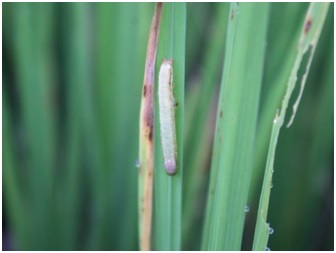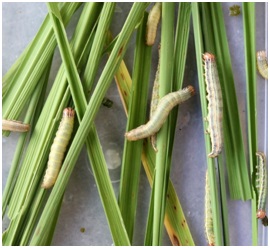PEST ALERT:
Swarming caterpillar/Army worm occurrence in paddy field of Ri-Bhoi district of Meghalaya
Incidence of Swarming caterpillar/army worm was detected in paddy field at Umroi-Nongra (Ri-bhoi) during survey and regular pest monitoring programme of the Division of Crop Protection, ICAR Research Complex for NEH Region, Umiam, Meghalaya. Occurrence of army worm caterpillars was observed only at one location in rice field of Mr. Shalan as on 11.09.2018. Surrounding rice fields were thoroughly observed, but they were found free from damage of Armyworm. Since the caterpillars were already reached to maturity stage (Plate 1-2) during survey, the concern farmers were suggested to take immediate action and follow pest management guidelines as suggested by ICAR institutes to control this pest from the infested paddy field and also to check its migration to nearby fields.
Introduction:
Swarming caterpillars are the important pest of rice, maize and several other host crops, often appear in outbreak form and cause huge losses. Generally they occur either singly or in combination of genus, Spodoptera and Mythimna (Lepidoptera: Noctuidae). Since they move in swarm or army, they are commonly referred as Swarming caterpillar/Army worm. They are voracious feeder and often cause severe losses in short period during vegetative and grain filling stage of rice, thus constant monitoring and immediate attention are needed to manage this pest species in time.
Factors Affecting Population Build Up:
- Prolonged dry condition followed by heavy rainfall favours its outbreak.
- Wind and rain storm helps in migration of moths to long distances.
- Pest occurs throughout the year on alternate hosts and move to paddy in kharif season
- Heavy rainfall leads to high mortality of larval population.
Management strategies suggested by ICAR-NCIPM, New Delhi and ICAR-CRRI, Cuttack
1. http://www.ncipm.org.in/NCIPMPDFs/Publication/Swarming_caterpillar.pdf
- Deep ploughing the field in summer exposes the hibernating larvae and pupae for predation by birds.
- Since pest occurs during rainy season, proper monitoring through light traps/ Pheromone traps should be started from July onwards to know its early infestation
- Remove excess weeds from the field and bunds, which serve as important alternate hosts
- Flooding the nurseries and small fields brings out the larvae to the surface, which get predated by the birds.
- Use of bamboo perches facilitates predation by birds.
- In case of severe infestation, small plots can be isolated and the movement of the caterpillars can be prevented by digging a trench around the infested field wherever possible.
- As the moths of swarming caterpillarsare attracted towards light, therefore, light traps can also be utilized for mass trapping of the moths
- Spraying of contact insecticides should be done at early stage of infestation on community basis to prevent its further spread.
- Fields adjacent to infested areas must be treated to check further spread
- In case of severe infestation, dusting with Malathion dust 2% helps to kill the migrating larvae and check its spread
- In emergency situation, spraying of Chlorpyriphos 20 EC @ 2.5 litres/ha may be done especially during evening hours to get better protection.
- Additional information is available on the following links:
2. krishikosh.egranth.ac.in/bitstream/1/.../1/CATERPILLAR%20BLTN%20final.pdf
D. M. Firake and G. T. Behere
Division of Crop Protection, ICAR Research Complex for NEH Region, Umiam-Meghalaya-793103

